
An eclipse is an astronomical event that occurs when an astronomical object or spacecraft is temporarily obscured, by passing into the shadow of another body or by having another body pass between it and the viewer. This alignment of three celestial objects is known as a syzygy. Apart from syzygy, the term eclipse is also used when a spacecraft reaches a position where it can observe two celestial bodies so aligned. An eclipse is the result of either an occultation or a transit.

Mercury is the first planet from the Sun and the smallest planet in the Solar System. It is a terrestrial planet with a heavily cratered surface due to the planet having no geological activity and an extremely tenuous atmosphere. Despite being the smallest planet in the Solar System with a mean diameter of 4,880 km (3,030 mi), 38% of that of Earth's, Mercury is dense enough to have roughly the same surface gravity as Mars. Mercury has a dynamic magnetic field with a strength about 1% of that of Earth's and has no natural satellites.
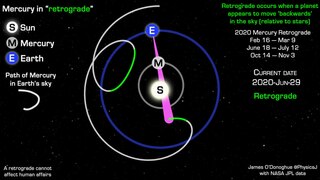
Apparent retrograde motion is the apparent motion of a planet in a direction opposite to that of other bodies within its system, as observed from a particular vantage point. Direct motion or prograde motion is motion in the same direction as other bodies.

In astronomy, a conjunction occurs when two astronomical objects or spacecraft have either the same right ascension or the same ecliptic longitude, usually as observed from Earth.
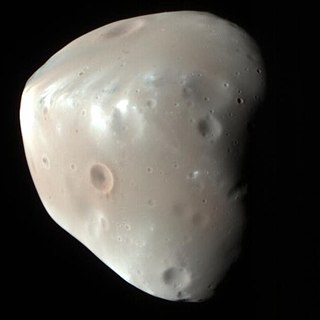
Deimos is the smaller and outermost of the two natural satellites of Mars, the other being Phobos. Deimos has a mean radius of 6.2 km (3.9 mi) and takes 30.3 hours to orbit Mars. Deimos is 23,460 km (14,580 mi) from Mars, much farther than Mars' other moon, Phobos. It is named after Deimos, the Ancient Greek god and personification of dread and terror.

In astronomy, a transit is a phenomenon when a celestial body passes directly between a larger body and the observer. As viewed from a particular vantage point, the transiting body appears to move across the face of the larger body, covering a small portion of it.
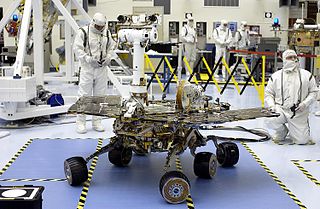
Spirit, also known as MER-A or MER-2, is a Mars robotic rover, active from 2004 to 2010. Spirit was operational on Mars for 2208 sols or 3.3 Martian years. It was one of two rovers of NASA's Mars Exploration Rover Mission managed by the Jet Propulsion Laboratory (JPL). Spirit landed successfully within the impact crater Gusev on Mars at 04:35 Ground UTC on January 4, 2004, three weeks before its twin, Opportunity (MER-B), which landed on the other side of the planet. Its name was chosen through a NASA-sponsored student essay competition. The rover got stuck in a "sand trap" in late 2009 at an angle that hampered recharging of its batteries; its last communication with Earth was on March 22, 2010.

In astronomy, an extraterrestrial sky is a view of outer space from the surface of an astronomical body other than Earth.

A transit of Mercury across the Sun takes place when the planet Mercury passes directly between the Sun and a superior planet. During a transit, Mercury appears as a tiny black dot moving across the Sun as the planet obscures a small portion of the solar disk. Because of orbital alignments, transits viewed from Earth occur in May or November. The last four such transits occurred on May 7, 2003; November 8, 2006; May 9, 2016; and November 11, 2019. The next will occur on November 13, 2032. A typical transit lasts several hours. Mercury transits are much more frequent than transits of Venus, with about 13 or 14 per century, primarily because Mercury is closer to the Sun and orbits it more rapidly.
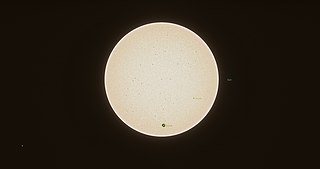
A transit of Earth across the Sun as seen from Mars takes place when the planet Earth passes directly between the Sun and Mars, obscuring a small part of the Sun's disc for an observer on Mars. During a transit, Earth would be visible from Mars as a small black disc moving across the face of the Sun. They occur every 26, 79 and 100 years, and every 1,000 years or so there is an extra 53rd-year transit.

A transit of Deimos across the Sun as seen from Mars occurs when Deimos passes directly between the Sun and a point on the surface of Mars, obscuring a small part of the Sun's disc for an observer on Mars. During a transit, Deimos can be seen from Mars as a small dark spot rapidly moving across the Sun's face.

A transit of Phobos across the Sun as seen from Mars takes place when Phobos passes directly between the Sun and a point on the surface of Mars, obscuring a large part of the Sun's disc for an observer on Mars. During a transit, Phobos can be seen from Mars as a large black disc rapidly moving across the face of the Sun. At the same time, the shadow (antumbra) of Phobos moves across the Martian surface.
A transit of a minor planet takes place when a minor planet passes directly between an observer and another heavenly body, obscuring a small part of that body's disc. From the perspective of observers on Earth, transits of the Sun and Moon by minor planets are very rare, as the minor planets orbiting between the Earth and those bodies are few and very small. Transits of the Sun would be more visible from the outer planets.

The two moons of Mars are Phobos and Deimos. They are irregular in shape. Both were discovered by American astronomer Asaph Hall in August 1877 and are named after the Greek mythological twin characters Phobos and Deimos who accompanied their father Ares into battle. Ares, god of war, was known to the Romans as Mars.
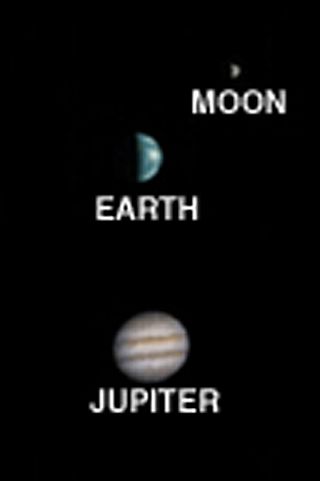
In many cases astronomical phenomena viewed from the planet Mars are the same or similar to those seen from Earth but sometimes they can be quite different. For example, because the atmosphere of Mars does not contain an ozone layer, it is also possible to make UV observations from the surface of Mars.

The two moons of Mars, Phobos and Deimos, are much smaller than Earth's Moon, greatly reducing the frequency of solar eclipses on that planet. Neither moon's apparent diameter is large enough to cover the disk of the Sun, and therefore they are annular solar eclipses and can also be considered transits.

In astronomy, a syzygy is a roughly straight-line configuration of three or more celestial bodies in a gravitational system.
The word "transit" refers to cases where the nearer object appears smaller than the more distant object. Cases where the nearer object appears larger and completely hides the more distant object are known as occultations.
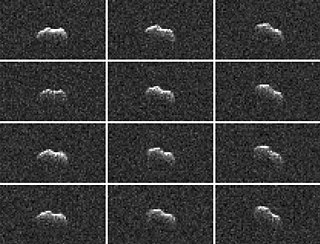
(231937) 2001 FO32 is a near-Earth asteroid classified as a potentially hazardous asteroid of the Apollo group. With an estimated diameter around 550 m (1,800 ft), it was discovered by the Lincoln Near-Earth Asteroid Research at Socorro, New Mexico on 23 March 2001. The asteroid safely passed by Earth on 21 March 2021 16:03 UTC from a closest approach distance of 0.0135 AU (2.02 million km; 1.25 million mi), or 5.25 lunar distances (LD). During the day before closest approach, 2001 FO32 reached a peak apparent magnitude of 11.7 and was visible to ground-based observers with telescope apertures of at least 20 cm (8 in). It is the largest and one of the fastest asteroids to approach Earth within 10 LD (3.8 million km; 2.4 million mi) in 2021.
2022 AP7 is a kilometer-sized Apollo asteroid and potentially hazardous object orbiting between Venus and Jupiter. It was discovered on 13 January 2022 by Scott Sheppard at Cerro Tololo Observatory. Based on its absolute magnitude (H), 2022 AP7 is likely the largest potentially hazardous object identified in the eight years prior to its 2022 discovery.


















